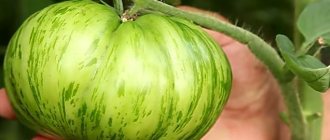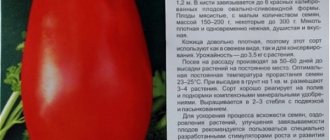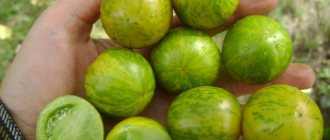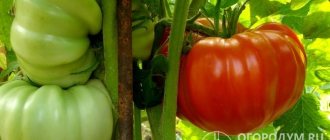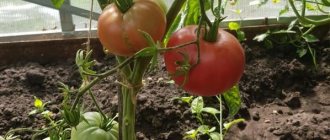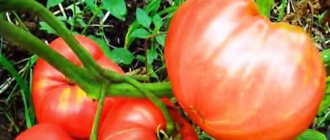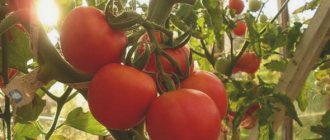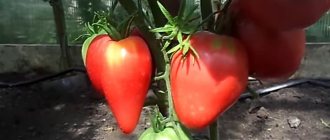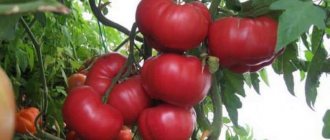Tomato Pink Siberian Tiger is an original hybrid variety from the anthocyanin class. Despite the name, it was created in the USA and has excellent taste and decorative qualities.
| Height | Landing location | Ripening time | Fruit color | Fruit size | Origin | Fruit shape |
| Tall | Greenhouse, Open ground | Mid-season | Bicolor | Average | Hybrid | Flat-round |
Description of tomato Siberian Tiger
The Siberian Tiger tomato was created by US scientist breeders under the leadership of Mark McCaslin by crossing two other types of tomatoes - the King of Beauty and the Blue.
This vegetable belongs to the indeterminate species and is rightfully considered an exotic variety. This tomato was included in the State Register in 2015. Description of the Siberian Tiger tomato:
- the plant is tall and when grown indoors its height can reach 1.5-2 m;
- the leaves are long, thick, bright green;
- foliage is average;
- inflorescences of the intermediate type are quite powerful, with a large number of ovaries - 3-7 pieces on one stem;
- Up to 6-8 tomato tassels are formed on one shoot.
Description of fruits
The fruits of the Siberian Tiger tomato, found in our country, have a round shape, resembling a ball or semicircular. The skin of tomatoes is smooth. But American-bred vegetables have a peculiar ribbing. The structure of the fruit is dense, the pulp is tender and fleshy, the skin is thin.
Important! The shape of the fruits of the Siberian Tiger variety may differ among different companies that produce one or another batch of seeds.
The color of unripe tomatoes is light green, with characteristic stripes emerging. It was thanks to them that the variety got its name - “Siberian Tiger”. These stripes make the color of the tomato similar to the color of the animal's skin. Fully ripe tomatoes are purple-pink in color with prominent black lines. The tomato's shoulders near the stalk have a blue-violet tint.
Attention! The brightness of the color depends on access to sunlight. Siberian Tiger fruits ripen under bright sunlight and have a more intense and exotic color.
The average weight of a ripe tomato is about 150-200 g, on the first cluster up to 300-400 g. The fruits of the Siberian Tiger are multi-chambered, with a large number of medium-sized seeds. The tomato pulp is red, with a sugary structure at the fracture. The taste of tomatoes is sweetish, with a pronounced fruity aroma.
Growing
If you plan to grow tomatoes in an area with a warm climate, then it is better to do it in open ground. For the middle zone and Siberian regions, greenhouse conditions would be the most suitable option.
Growing in a greenhouse
Tomato Danko
Planting of seeds should be done 1.5 months before moving the seedlings to the greenhouse. Sowing is carried out in early April if the tomato is planned to be grown in open ground, or at the end of March if further planting in a greenhouse is planned. Immediately before sowing, the substrate is moistened. When 2-3 true leaves appear, be sure to pick them at a distance of 7-10 cm from each other.
There is no need to fertilize the seedlings. If there is a lack of sunlight on the north side, a phytolamp may be needed. The duration of daylight for normal growth of tomatoes should be at least 15 hours. After the soil warms up to +15°C, tomatoes can be planted in the ground. This is usually done in the first ten days of June, after the danger of frost has passed. Plants are placed in rows. The distance between them should be 30-40 cm. The distance between the rows is 30-50 cm. After a week, the tomatoes begin to be fed with nitrogen-containing mixtures. During the period of flowering and fruit ripening, plants are fertilized with potassium and phosphorus.
On a note. Before placing seedlings in the ground, you need to make holes and thoroughly water them. Tomatoes are removed from the cups or removed from the greenhouse and immediately planted in the garden. If you wait a few hours, the plants will wither, take root poorly and will lag behind in development.
Before planting seedlings, it is recommended to add a little humus to each hole. If tomatoes are grown in a greenhouse, the bush must be combined into one or two stems. It is also very important to remove side shoots, otherwise part of the crop will be spoiled. Before the end of the growing season, the growing point is pinched (the top of the main shoot is removed). Thanks to these actions, the number of fruits will increase significantly, and the period of fruit ripening will be reduced. The bush must be tied up.
Why tie up tomatoes?
If this is not done, the harvest can be seriously damaged:
- being in wet soil, tomatoes are likely to rot;
- fruits that come into contact with the ground can become prey for slugs and other pests;
- If the plant is not strengthened, the stem will not withstand the weight of ripening fruits and will break.
It is convenient to tie the Tiger tomato to a trellis. This method involves driving high (from one and a half meters) stable stakes into the ground at different ends of the bed. A strong trellis is installed between them, to which the plants are tied.
Durable trellis
It should be borne in mind that the previous place for a new planting can only be used after 2-3 years. Fresh manure should never be used as fertilizer. Otherwise, the active growth of the stepsons will begin, the leaves will become large, and the stems will be much thicker, while the fruits will ripen more slowly and set worse.
On a note. This variety loves fertile, light soils, where cabbage, carrots, and cucumbers were previously grown. It is not recommended to plant tomatoes after peppers, potatoes, and eggplants earlier than three years. Otherwise, the plants will get sick.
Features of caring for the variety
To obtain a high yield, Amur Tiger tomatoes need high-quality fertile soil. The turf soil is fertilized in advance with rotten compost, mullein and mineral additives.
During the growth period, nitrogen compounds are added, and after flowering begins, superphosphate, potassium nitrate or complex fertilizers are added. The vegetable garden, greenhouse and garden tools should also be disinfected before planting, which will help avoid fungal infections.
How do cabbage seedlings tolerate spring frosts and are the cabbage crop afraid of cold weather?
Proper care also includes observing the norms and watering regime. The water temperature should not be lower than +25°C. The procedure is carried out carefully to avoid the formation of a crust on the surface of the earth. Therefore, watering should be combined with weeding and loosening the soil.
Moisture on the leaves should be avoided, as this negatively affects the health of the tomatoes. Waterlogging of the soil during fruit growing leads to the appearance of acid in the taste of tomatoes.
Amur Tiger bushes need to be formed throughout the entire growing season. After flowering, you need to pinch out the growing points and the top of the main stem.
Stepchildren in the lateral axils need to be cut off as they appear, so that the energy of the crop goes to fruiting, and not to thickening the plants.
Tall tomato bushes need to be tied to a support to relieve the load on the stem.
In some cases, the flowers of the variety are susceptible to doubleness, which leads to the formation of irregularly shaped tomatoes. Despite their large size, the fruits look unappetizing. Therefore, it is better to remove large flowers of a changed appearance immediately after detection.
Characteristics of tomato
When planting a tomato variety Siberian Tiger in the southern zone, you can get an excellent harvest in open ground. In middle and northern latitudes, it is better to grow this tomato in greenhouses and film shelters, since its fruits do not tolerate cold temperatures well.
Productivity and fruiting
The Siberian Tiger variety is mid-season - technical maturity occurs 110-120 days after emergence. With the right agricultural technology, you can achieve good yields: from 1 bush - 3-4 kg, and from 1 sq. m - up to 12 kg.
Recommendations for increasing the yield of Siberian Tiger tomatoes.
- Tomatoes love fertile, light soil. The best predecessors are beans, carrots, cucumbers and cabbage.
- It is not recommended to plant tomatoes in the same place earlier than after 2-3 years.
- When growing crops in a greenhouse, it is necessary to monitor the temperature regime. Temperatures exceeding plus 32 can be detrimental to tomatoes. It is also important not to forget about ventilation.
- Fresh humus cannot be used. This can increase the growth of stepsons and large leaves, and the stem, on the contrary, will become thinner. The fruits will set worse and grow slower.
- It is necessary to remove the stepsons in a timely manner, otherwise part of the harvest will be lost.
- Tomatoes do not like excess moisture, so do not overdo it with watering.
- To increase the ovary, the bushes can be sprayed with boric acid (0.02% solution).
- Do not overuse leaf breaking to increase yield. Without these actions, you can get the opposite effect. After all, the leaves provide the plant with useful substances and vitamins. Only diseased and damaged leaves should be removed from tomatoes.
Advice! As soon as all the fruits on the first cluster are ripe, you can cut off all the leaves above it. This should be done throughout the growing season. But it is not recommended to remove more than 3-4 leaves per week on one tomato bush.
Area of application of fruits
Tomatoes of the Siberian Tiger variety can be consumed both fresh and for preparing a variety of dishes. From ripe tomatoes it is easy to prepare canned salads for the winter, lecho, ketchups, sauces, adjika, Spanish gazpacho soup, tomato paste and juice. You can add them to salads, stews, soups, pizza. Due to the high acid content in fruits, they are harmoniously combined with meat dishes, both fresh (as a side dish) and in the form of sauces and marinades.
Resistance to diseases and pests
The Siberian tiger has strong immunity to the development of many viral, infectious and bacterial diseases. The bushes are not subject to attack by various pests. If you follow all the recommendations for growing and caring for tomatoes of this variety, you don’t have to worry about any problems with yield.
Advantages and disadvantages of the variety
Based on the description of the variety and reviews from gardeners about the yield, we can highlight both the advantages of the Siberian Tiger tomato (photo) and its disadvantages.
Advantages of tomato:
- exotic coloring;
- excellent and unusual taste characteristics;
- can be grown both indoors and outdoors;
- large weight of fruits;
- a large number of ovaries are formed;
- fruits are not prone to cracking when watering;
- tomatoes hold well on the stalk when overripe;
- resistance to cracking when overripe;
- versatility of fruits;
- high yield.
Every vegetable has its downsides. This variety is no exception. Disadvantages of the Siberian Tiger tomato:
- the plant is tall, so its growth must be restrained by pinching the top of the main stem;
- the need to tie up not only the stems, but also the bunches;
- needs pinching, since it is recommended to form the plant into only 1-2 stems, so as not to overload;
- the fruits have thin skin, so the variety is not suitable for whole-fruit canning;
- The Siberian tiger is not very suitable for transportation. Delicate skin is severely damaged from any physical impact, so they should be placed in boxes carefully and neatly, in one row;
- fresh harvested crops are not stored for a long time;
- in a warm climate zone, all clusters ripen even when grown in open ground. In other latitudes, it is preferable to grow this variety in greenhouses.
Taste qualities of tomatoes
Tomatoes have excellent taste. The tomatoes are sweetish with a slight sourness. If the plant received little sunlight and heat, or grew in cold weather or rainy periods, the fruit will be more sour.
Tomatoes Tiger Cub are characterized by high yield. From 1 m² you can harvest about 10 kg of tomatoes. Tomatoes tolerate transportation well and are stored well for quite a long period. During the entire storage period of these tomatoes, their wonderful taste and appearance remain unchanged.
Tomatoes can be used fresh, canned, used for making sauces, gravies, and seasonings. They can be fried and boiled, and used to prepare various dishes. Thanks to their original color and excellent taste, these tomatoes look great if they are pickled whole.
The plant is hardy and resistant to various diseases, such as late blight and gray rot.
Characteristics and description
Pink Siberian Tiger is an indeterminate, mid-season variety. The fruits ripen 110–120 days after emergence. The height of the bush is 1.3–1.5 m.
The leaf blades are slightly elongated, large, dark green. The foliage is average. In simple inflorescences 4–6 fruits are formed. The number of brushes on the stem is 6–7.
In the southern regions, it is recommended to grow tomatoes in open ground, and in the central and northern regions, including Siberia, in greenhouses. The variety is resistant to most tomato diseases.
Gardeners who grew the American variety highlight the following advantages:
- Exotic tomato color.
- Pleasant and unusual taste.
- Tomatoes are resistant to falling and cracking.
- The versatility of the fruit.
The description also contains several shortcomings:
- Due to their large growth, the bushes have to be pinched and shaped.
- The fruits are not suitable for whole-fruit canning.
- The variety can be grown in garden beds only in the south of the country.
Depending on the agricultural company and the date of seed release, the description of the fruit may vary. In most cases, tomatoes are spherical and slightly ribbed. Tomatoes at technical ripeness are light green with a green spot in the form of thin stripes at the stalk. Upon reaching biological ripeness, the fruits are colored purple-pink, and the stripes are purple and black. According to many gardeners, the top of a tomato resembles a tiger skin. The red flesh is fleshy, juicy, and sugary when cut. There are many seed chambers and seeds. The skin is thin.
The weight of the fruit varies from 150 to 300 g. The largest tomatoes are formed on the first cluster. The fruits are suitable for making salads, tomato juices and pastes.
Growing rules
When purchasing Siberian Tiger tomato seeds, you should pay special attention to their packaging. It should have the inscription “for open ground”. It is also necessary to take into account the timing of fruit ripeness. In open ground, tomatoes ripen in 115 days, and in a greenhouse, the first harvest of the Siberian Tiger can be harvested in 95-105 days.
Planting seedlings
Sowing of Siberian Tiger tomato seeds should be carried out from March 15-20 for planting in a greenhouse and from April 5 to 10 for cultivation in open ground. It is carried out in previously prepared soil. You can purchase ready-made substrate in specialized stores or prepare it yourself. To do this, it is necessary to combine components such as turf soil, humus and compost (1:1:1). To improve the soil structure, you can add wood ash and washed river sand.
Step-by-step instructions for planting Siberian Tiger tomato seeds for seedlings.
- It is recommended to pour boiling water over the soil and container for growing seedlings before sowing seeds (possibly with the addition of manganese). To enhance the effect, they can be covered with some kind of cloth. It is also recommended to calcine the soil in the oven at a temperature of plus 55-60.
- The seeds should also be subjected to preliminary preparation. To do this, they are immersed in salt water for 15 minutes to reject unsuitable specimens. Weak and unripe seeds will simply float to the top.
- The seeds are washed with warm water and immersed in a weak solution of potassium permanganate. After which they must be dried to a free-flowing state. Important! The creators of the variety do not recommend soaking and germinating Siberian Tiger tomato seeds.
- The soil poured into the seed container should be moistened. Seeds are planted at a depth of 0.8-1.5 cm.
- Until the sprouts appear, the box should be placed in a warm, well-lit place, for example, on a windowsill.
- After the seeds germinate, the greenhouse is opened. The temperature also needs to be lowered slightly to prevent the seedlings from stretching.
Advice! You can speed up germination by covering the container with the sown seeds with glass or film. The created microclimate will allow you to see the first shoots in 4-5 days.
When forming the first 2. The leaves are picked into separate cups.
Tomato transplant
Seedlings must be hardened off before planting in open ground. The stems of plants ready for the procedure should acquire a purple tint. Experts advise planting seedlings of this variety in late spring or early summer (from May 15 to June 5), in well-warmed soil. Tomatoes are planted in a permanent place at the age of 55-60 days, when the 5th leaf is formed.
Advice! It is not recommended to plant tomatoes in areas where potatoes were previously grown. They do not like acidic soils, so it is recommended to add compost, lime, and ash to the soil.
Before planting, each hole should be treated with a disinfectant solution (water with potassium permanganate). It is also necessary to pour a handful of wood ash into the hole. Seedlings of the Siberian Tiger variety are planted according to the following scheme: 50 cm x 50 cm. Accordingly, per 1 sq. m is not recommended to place more than 4. bushes Dense planting significantly reduces the yield of the variety.
Subsequent care for tomatoes
Caring for the Siberian Tiger tomato variety involves a number of agrotechnical measures. The area intended for growing tomatoes is prepared at the beginning of the planting season. To do this, the soil in the garden bed needs:
- fertilize;
- dig up;
- add humus.
Immediately after planting Siberian Tiger seedlings, watering should be carried out, followed by mulching the soil with fiber or organic matter (sawdust, straw, hay). It is recommended to cut off the first leaves and shoots even before the fork appears. In a greenhouse, the formation of a bush should be carried out in 1-2 stems. In open ground you can leave about 3. stems. The plant needs staking and installation of supports.
During the growing process, the area with tomatoes should be periodically loosened, after watering and heavy rains, freed from weeds and hilled up. Tomato bushes should be watered at least once every 7 days. And in dry times, the plant needs water at least 2 times a week.
Important! Regular watering promotes fruit growth. Lack of moisture will cause Siberian Tiger tomatoes to gradually wilt.
Tomatoes of the Siberian Tiger variety do not need constant feeding, but only at times favorable for growing (sunny weather). If the summer is rainy, then it is recommended to add fertilizer to each bush. In the first half of the growing season, nitrogen fertilizers, in the second half - potassium-phosphate fertilizers.
Features of cultivation and care
Seeds for seedlings are sown in large or small containers filled with a purchased mixture. The soil mixture can also be prepared independently: for this purpose, turf soil, rotted manure and compost are mixed based on a 1:1:1 ratio. Regardless of the origin of the soil, disinfection is carried out: the mixture is calcined at a temperature of +55–60 degrees or spilled with a hot pink solution of potassium permanganate.
To destroy pathogenic bacteria on the surface of the seeds, planting material is soaked for 15 minutes in a weak solution of potassium permanganate. Please note that the authors of the variety do not recommend germination.
After emergence of shoots, care should include:
- Watering. Tomatoes, especially those growing in a greenhouse, do not tolerate high humidity well, so you need to water the bushes rarely, but abundantly. Prolonged drought and waterlogging significantly worsen yields or lead to plant death.
- Feeding. Complex or organic fertilizers are used as nutrient mixtures. In the first half of the growing season, nitrogen-containing fertilizers are applied, in the second - potassium-phosphorus fertilizers.
- Dive. The seedlings are transplanted into separate cups after the formation of 2 true leaves. Tomatoes are planted in a permanent place at the age of 55–60 days, when the 5th leaf is formed.
- Loosening and weeding. The simplest, but at the same time very important manipulation. The soil in the garden bed is loosened after watering and heavy rains. Weeds are destroyed as they grow.
Margarita, 42 years old: “I love tomatoes, so every year I add new varieties to my collection. The Pink Siberian Tiger tomato pleased with its beautiful appearance and unusual taste. The yield could have been better - it was possible to collect 2 kg of fruit from one bush.”
Ivan, 56 years old: “During my life I grew about 1000 varieties of tomatoes. The Siberian Tiger tomato was remembered for its sweet taste and bright color. The characteristics attached to the variety fully corresponded to the grown plants. The fruits were used to make salads and tomato pastes. I recommend".
Have you ever grown the Siberian Tiger variety? What impressions did you have from this plant? Leave reviews so that gardeners have less doubt about the correctness of their choice.
Read also: Pests of pepper seedlings: how to treat pepper seedlings against pests
Recommendations
It is allowed to plant tomatoes again in the previous place no earlier than after 2-3 years. Please note that under no circumstances should you throw fresh manure. By doing this, you will only make it worse: the stepsons will begin to grow actively, large leaves will form, the stems will become much thicker, and as for the fruits, they will set much worse and grow very slowly.
Break off leaves as little as possible; some gardeners do this in order to get a higher yield, however, if you abuse this, you can get the opposite effect. Thanks to the leaves, the fruits receive the necessary beneficial vitamins and substances, so break off only low-quality, diseased leaves. When the first cluster from below is filled with ripe fruits, the leaves underneath can be safely cut off. Then, as they ripen, remove the leaves from the tomatoes, but keep in mind that you need to pick no more than 3-4 leaves per week and be sure to remove the stepsons on time, otherwise part of the harvest will be lost.
To make tomatoes set better, it is recommended to spray them with boric acid (0.02 percent solution).
You shouldn’t water Amur Tiger tomatoes often; it’s better to do it rarely, but do it well. Be sure to loosen and hill up the tomatoes, they love it very much.
If you plan to grow tomatoes in a greenhouse, keep in mind that temperatures above 32 degrees have a negative effect on them. They gradually begin to fade. Constantly monitor the indicators and ventilate if necessary.
This crop loves highly fertile, light soils. It’s good if cucumbers, cabbage, beans, and carrots grew on it before.
Description and characteristics of the variety
The pink Siberian Tiger tomato was created on the basis of the Blue and King of Beauty varieties.
- Variety, not hybrid.
- Gives a good harvest in the southern regions when grown in open ground. In central Russia, pink Siberian Tiger variety of tomatoes is best grown in greenhouse conditions.
- Indeterminate, with unlimited growth. In a greenhouse it grows up to 1.5 meters (in a greenhouse) and requires obligatory gartering to a support or trellis.
- Not standard. Requires pruning once a week. It is necessary to pinch the stepsons very carefully, leaving a stump of 5-7 mm, so as not to damage the main stem.
- The average ripening period, ripe fruits appear on the bushes 110-120 days after the seeds germinate.
- The leaves are long and deep green. The foliage is average. To improve air circulation, it is recommended to tear off the lower leaves.
- 6-7 flower-bearing racemes are formed on one stem. The flower stalks are powerful, each producing 4-6 ovaries.
- The bush is formed into 2-3 stems.
- The variety is resistant to nightshade diseases.
- Productivity is below average.
Resistance to diseases and pests
Varietal tomatoes Amur Tiger are highly resistant to diseases of nightshade crops. Only late blight poses a danger to tomatoes. To prevent the disease, ventilation and a constant flow of warm air in the greenhouse should be established. Before flowering, the bushes are treated with fungicides.
How to return money for low-quality furniture and return the goods to the store after assembly, consumer protection law
Subject to the rules of agricultural technology, plants are not susceptible to pest infection. Tomatoes should not be grown in the same place. Disinfection of seeds prepared independently, or purchasing planting material from a reliable manufacturer will help protect the crop.
Description of the variety
The Blue and King of Beauty varieties were chosen as the parents of the new Siberian Tiger tomato. In the southern regions, the tomato produces good results in open ground, but in the middle zone it is recommended to grow it in greenhouses.
Features of the bush
The exotic pink tomato Siberian Tiger is an indeterminate variety. The plant is mid-season, technical maturity occurs 110-120 days after germination.
Tomato bushes are tall, up to 1.5 meters (in a greenhouse), and cannot be grown without support and tying. To get a decent harvest, you need to pruning and removing excess leaves. A bush of 1-2 stems is formed.
The leaves of the American tomato variety are rich green. They are long and have medium foliage. Peduncles are powerful, with a large number of ovaries (from 4 to 6). About 6-7 tassels of tomatoes are formed on one stem.
Fruit
The shape of the tomato does not always correspond to the description on the bag. The thing is that this tomato is still being improved.
Attention! In addition, different agricultural companies produce Siberian Tiger tomato seeds, perhaps the form differs for this reason.
That’s why gardeners write in reviews that tomatoes are semicircular or resemble a ball. On American variety tomatoes, regardless of the shape of the fruit, ribbing is observed.
The Siberian Tiger tomato variety has dense flesh and is fleshy, but the skin is thin. Unripe fruits are light green in color with emerging stripes. In technical ripeness, you can’t take your eyes off this tomato variety. This exotic fruit of American origin will not leave anyone indifferent.
Tomatoes of the Siberian Tiger variety are distinguished by their bright purple-pink color. The shoulders of the stalk become violet-blue in color, and there are also stripes reminiscent of the colors of a tiger.
Attention! Tomatoes that are well illuminated by the sun acquire a particularly bright color.
The weight of the fruit on the first cluster is 300 grams and slightly higher. The remaining inflorescences produce tasty, sweet tomatoes with a fruity aroma, weighing about 150 grams.
The fruits of this variety are multi-chambered and sugary when cut. The flesh is deep red. Tomatoes have a lot of seeds and are medium in size.
Description
The variety was bred by American breeders, its author is Mark McCaslin. The parents of the Siberian tiger are considered to be the Blue variety and the King of Beauty. In the south of the country it can be planted in open soil; in regions with unstable weather conditions, planting in greenhouses is recommended. The plant belongs to indeterminate varieties. Refers to mid-season tomatoes, the fruits ripen 110-120 days after the sprouts appear on the surface of the ground.
The bushes can grow up to 180 cm in height. The stem is quite powerful, medium leafy, the leaves are long, rich green. The fruits grow in clusters, with 4 to 6 ovaries formed on one. There are usually 6-7 tassels of tomatoes on the stem.
The shape varies and may not correspond to the description on the package, perhaps this is because the variety is still being improved. Tomatoes can be semicircular or spherical, but in any case with pronounced ribbing. Weight can vary from 150 to 300 grams; on the lower tiers the fruits are usually larger. The skin is thin, the flesh is red, fleshy, multi-seeded, the fruits are multi-chambered, the seeds are not large. The cut shows pronounced sugar content. The tomatoes are distinguished by their original color; they are purple-pink, and on the hangers there are purple-blue strokes.
Important! Every year you need to buy new seeds, collected from the harvest are not suitable for cultivation.
This variety has a salad purpose. Tomatoes can be eaten fresh or added to various dishes. Suitable for making lecho, ketchup, dressings and sauces. They are not suitable for whole-fruit canning, since their skin is very thin.
They are subject to long-term storage, but care is required during transportation, as the fruits can be easily damaged
Advantages
- Great taste.
- Extraordinarily beautiful appearance.
- Good yield.
- Universal application.
- The fruits do not crack if you do not overdo it with watering.
Unfortunately, this variety also has its disadvantages.
Flaws
- The plant must be pinched in time to limit its growth.
- It is necessary to form the stem and remove the stepsons.
- You can’t do without a garter, and not only the stem, but also the brushes.
- Requirement for good weather conditions.
Get to work!
So, all the stages of growing a variety are detailed. I bought the seeds from a local agricultural company. The package said “for open ground,” but I only planted it in a greenhouse.
I planted seeds for seedlings at the end of March. I bought land in a store. Although it was possible, of course, to prepare it yourself, as last year, according to the principle: humus, compost, earth equally. I added a little more river sand and ash from the country stove. But for some reason I’m not very keen on exploits lately.
The seedling container was doused with boiling water and a weak solution of manganese. I kept the soil in the oven at 60 degrees. Of course, I also processed the seeds: I poured them into salted water for a quarter of an hour.
Several seeds floated to the surface, I removed them - that means they were unusable. Then I washed it and kept it in manganese for a while and dried it. There is no need to soak for a long time and germinate the seeds of the “Siberian Tiger” variety - this method is absolutely not suitable for them.
Then I planted the seeds in moist soil in small containers. Not too deep: a centimeter and a half. I placed the containers on a large windowsill on the sunny side. Then she took it to the greenhouse when the sprouts appeared. The temperature there was ideal for them, because the spring this year was not cold, but good.
I placed several containers in a long tray with a lid and covered them. This is how early shoots are achieved. As soon as the first two leaves hatched, I planted the seedlings in separate peat pots.
Care
Tomato Bugai
It is believed that you can increase productivity by removing leaves, but you should not abuse this, otherwise the effect will be completely opposite. Due to the leaves, the fruits are saturated with vitamins and other beneficial substances. Thus, only diseased, low-quality leaves, as well as those located under stems with ripe fruits, need to be broken off. Leaves are removed gradually, in the amount of 3-4 per week.
Note! Removing part of the leaves in the lower part of the stem (up to 1/3 of the height) ensures good ventilation of the plantation, which helps prevent various diseases in tomatoes.
To make the setting process more active, it is recommended to spray the tomatoes with a solution of boric acid.
You should not water the plant frequently. One high-quality watering 2 times a week is enough. The soil must be loosened and the tomatoes hilled.
If tomatoes are grown in greenhouse conditions, the air temperature should not exceed 32 °C. Exceeding this norm will cause the plants to wither. It is necessary to constantly monitor temperature indicators and ventilate the room as needed.
Wilting tomato
Fruit
They are very beautiful! In the photo I saw them completely striped, really looking like the skin of a tiger or a St. George’s ribbon. I didn’t grow any of these, but there was a pleasant play of dark red, pinkish-scarlet and purple shades.
Tomatoes are ribbed, roundish in shape. The skin is quite thin and I like it - I enjoyed cutting them into salads. And the family devoured them, too, with pleasure.
These tomatoes have a fairly high acid content, so I was happy to make vegetable kebabs from them, add them to meat, and cook tomato sauce. I made canned food. Quite!
The sunny the place where you planted your “tiger cubs”, the more beautiful the color will be. They love the sun very much. The weight of the tomato ranges from 150 to 300 grams. If you do everything correctly and take good care of the bushes, you will get a harvest of 3.5 kg per bush.
What does "correct" mean? I'll explain now:
- Don’t get too carried away with breaking off the leaves: the leaves provide the fruits with everything useful and nutritious, so don’t harm your tomatoes with excessive zeal.
- Don't forget to ventilate the greenhouse. Even such heat-loving “Americans” do not like excessive heat - it should not be more than 32 degrees.
- Be careful with fresh manure - instead of a large harvest of fruits, you will get a huge harvest of leaves and shoots. But it’s good if you collect a kilogram of fruit.
- The best “predecessors” of the variety are legumes, cucumbers, cabbage, and carrots.
- Don't forget to stepchild! Otherwise, you will have a lush jungle with stunted fruits: everything will turn into greenery.
- Do not flood the bushes - this variety does not like excessive moisture.
- A little secret: when all the fruits on the first cluster are ripe, cut off all the leaves above it. Do this throughout the entire ripening period. But do not tear more than 4 leaves on one bush per week.
Characteristics of the variety
Based on the description of the Siberian Tiger tomato, we will find out its advantages and disadvantages.
pros
- Exotic appearance.
- Excellent and unusual taste properties.
- Possibility of growing tomatoes in open and protected ground.
- Not a bad yield, considering the weight of the fruit and the number of formed inflorescences and ovaries.
- This variety of tomatoes does not crack on the bushes if watering is not too abundant. They hold up well and do not fall off, even when overripe.
- Siberian Tiger tomatoes are universally used. An excellent raw material for sauces, tomato juice, making lecho, ketchup and salads for the winter.
- The transportability of the variety is average; due to the thin skin, the fruits require special placement in boxes.
Important! The originators of the tomato claim that the Siberian Tiger is resistant to many diseases that affect other nightshade crops.
Minuses
As you can see, there are many advantages. Let's look at the disadvantages:
- A tall determinate plant must be limited in growth by pinching the main stem.
- Tomato varieties need to be formed into only one or two stems so as not to overload the plants, therefore, pinching is indispensable. Tomatoes need to be tied not only the stems, but also the bunches, as shown in the photo.
- The variety is not suitable for canning whole fruits due to its thin skin.
- In southern conditions, all brushes ripen even in open ground. In the risky farming zone, the Siberian Tiger variety of tomatoes can only be grown in a greenhouse.
Comment! It is not recommended to collect tomato seeds of this variety yourself, because it is unknown what will happen.
As you can see, tomato has both advantages and disadvantages. But without starting to grow a plant, it is difficult to judge it. Therefore, we recommend that you try to grow an exotic plant, and then send us your feedback about the Siberian Tiger variety tomatoes, as well as add to the description and characteristics.
Interesting varieties of tomatoes:
Advantages and disadvantages
This variety has its advantages and disadvantages. The advantages include the following qualities:
- Exotic appearance.
- Excellent taste.
- Can be grown in open and closed ground.
- Not a bad yield, considering the weight and number of tomatoes.
- Tomatoes stay on the stalk well and do not fall off, even after full ripening.
- Can be transported over long distances if properly packed in boxes.
- Tomatoes of the Siberian Tiger variety are resistant to nightshade diseases.
The disadvantages include the following qualities:
- Due to the unlimited growth of the bush, it must be tied to supports and the main stem pinched when it grows to a certain height. The stems and bunches of tomatoes need to be tied up.
- Tomatoes are prone to cracking, but this can be avoided by reducing watering while the fruit is ripening.
- Requires stepsoning.
- Not suitable for whole canning due to thin skin.
- Tomato varieties of the Siberian Tiger variety can be grown in regions of risky farming only in a greenhouse.
Comment! It is not recommended to collect seeds of this variety yourself.
Agricultural technology varieties
As indicated in the characteristics and description of the variety, the Siberian Tiger tomato can be grown in any soil, depending on the climatic conditions of the region.
Preparing seedlings
- Tomato seeds of this variety are planted in prepared soil in containers convenient for every gardener. The soil can be purchased at the store (it is completely balanced) or you can prepare it yourself by taking equal parts of soil from the garden bed, compost or humus. To improve the soil structure, add a little sand, and to combat blackleg, add wood ash.
- The soil and container must be disinfected. As a rule, boiling water with potassium permanganate added to it is used. The pink solution is poured onto the ground and covered with a thick cloth to improve the effect of the treatment.
- Tomato seeds also need to be prepared. They are first poured into salt water to select frail and immature specimens (they will float to the top). Then they are washed in warm water and placed in a pink solution of potassium permanganate for about 15 minutes. Wash again and dry to a free-flowing state. It is not recommended to soak and germinate seeds of the Siberian Tiger tomato variety.
- Dry seeds are placed in sowing containers to a depth of no more than 1.5 cm (ideally 8-9 mm) in moist soil. Cover the top of the container with a piece of cellophane to speed up germination. Before germination, the box is placed in a warm, lighted window. Thanks to the greenhouse effect, tomato seeds germinate within 4-5 days. The film is removed and the temperature is reduced slightly so that the seedlings do not stretch. To save space on the windowsill, seeds can be grown in a snail. And the video below will help those gardeners who are using this method of planting tomatoes for the first time to cope with the work:
- When two or three true leaves appear, pick them into separate cups with a volume of at least 500 ml. In smaller containers, plants will feel uncomfortable, which will negatively affect the seedlings.
- Before planting in a permanent place, glasses with Siberian Tiger tomatoes are taken out into the fresh air for hardening. Tomatoes that are ready for planting will have a bluish tint to their stems.
Growing seedlings
For planting, you need to prepare convenient containers; you can purchase ready-made soil or make it yourself by mixing soil from the site and humus in equal parts, you can also add a little river sand to improve the structure of the soil and wood ash, which perfectly fights blackleg.
The soil and seeds are disinfected before sowing, using a pink solution of manganese, its temperature should be 100 degrees. After processing, the container with soil is covered with thick cloth. Preparing seeds involves checking for similarity; for this they are placed in a saline solution; any seeds that float are considered unsuitable. Those remaining lying on the bottom are disinfected, washed and dried to a flowable state.
Important! It is not recommended to soak and germinate the seeds of this variety. Dry seeds are sown in moist soil to a depth of 1 cm, covered with cellophane on top and placed in a warm place; thanks to the greenhouse effect, the seeds germinate faster, usually within 4-7 days
After seedlings appear on the surface of the soil, the cover is removed, the plants are watered, and the container with seedlings is placed in a well-lit place, the temperature is reduced by several degrees
Dry seeds are sown in moist soil to a depth of 1 cm, covered with cellophane on top and placed in a warm place; thanks to the greenhouse effect, the seeds germinate faster, usually within 4-7 days. After the seedlings appear on the surface of the soil, the shelter is removed, the plants are watered, and the container with seedlings is placed in a well-lit place, the temperature is reduced by several degrees.
When 2-3 leaves appear on the plant, you can pick them into separate containers. Before planting, the seedlings are taken out into the fresh air for several days, thus hardening occurs. The bluish tint of the stems indicates readiness for transplanting into the soil.
